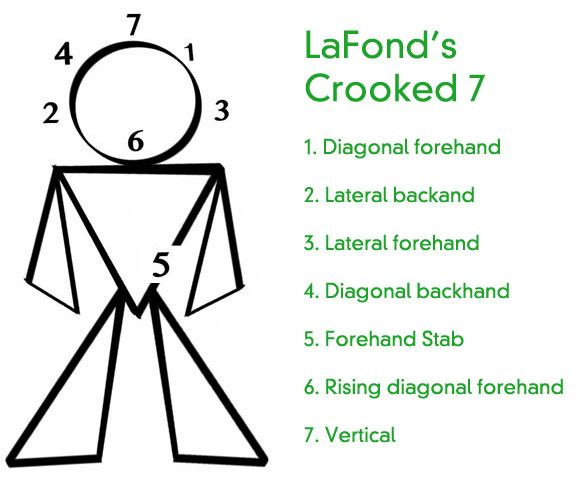Using FMA counts as the basic reference for getting new stick fighters and self-defense people up to speed is problematic.
First there is the fact that any FMA count with much variance in it is prone to have blade strokes mixed in with stick stokes, or in fact be a pure blade count.
Secondly, since FMA teaches weapons first and empty hand later, some of the stick counts are intentionally done as ‘mirror-image’ coordination drills to facilitate empty hand training.
For both of these reasons coaching fighters and self-defense people who have preexisting empty hand sets and who need effective and simple solutions yesterday, necessitates a series of digressions. We will come to the Doce Paras six and I will have to say, “Now this is not actually used in stick fighting, but...
For these reasons I decided to distill the seven essential stick strokes. The criteria was that I needed one stab, so that the ability to stop an opponent’s forward progress with the weapon was in the arsenal. I chose the stab that is most often used in free-style stick fighting, where there are no prohibitions against stabbing and where its only use is positional. This meant the count would be ‘crooked’.
Second, I took the three most often used forehands and three most often used backhands, with exceptions for effect. For instance vertical backhands and forehands are used in roughly equal measure. However, the backhand is more powerful by at least half. So we went with the vertical backhand. Erique and Craig worked this count with me for two hours until we had adjusted it three times to get the best flow.
The count below is meant as an introduction to stick-fighting and stick-based self-defense, and has no association with blade usage or any art what-so-ever. It is not perfect or comprehensive. It is meant to facilitate fundamental stroke development and to present a tactically sound sequence that can branch to ‘mobile’ egress or ‘stand-your-ground’ tactics in the last segment at count 5 and 6, which in a fight situation would often not be chained, but constitute a choice to stand or clear out.
The targets listed on the model are ‘preferred for effect’ and not necessary. The important aspect of this sequence is ‘stroke loading’ [or chambering] of the stick hand at the shoulders and hips. The stick is useless without power. Proceed from a hip guard or shoulder-load guard and practice slowly at first. After you get some speed on the stick, slow down, and practice this sequence with footwork. As a blade set this count works best with machete or saber length blades with a simple step & counter-step footwork. Try it out.
- A diagonal forehand, preferably to the head, perhaps a weapon beat, that follows through to your far hip or elbow. This is the first stroke in most FMA counts, and is the most functional weapon-beat.
- A lateral backhand across the ribs, or arcing up and then across the head, or as a beat, to a shoulder-load. This loads the next shot, which is the most powerful blunt extension stroke. You must have your checking hand ready on these lateral strokes.
- A lateral forehand to the head to a cross shoulder-load. Make sure the checking hand is at the ready near the elbow of the stick hand.
- A diagonal backhand to the collar bone or as a weapon beat, finishing at the lead hip [with or without a Redondo].
- A vertical stab to the liver. If you were fighting and you popped off the preceding sequence and decided to go with this stab, your next stroke would probably just be a beat or a pass meant to get you to a chamber for stroke 7.
- From the same hand position a rising diagonal forehand to the hand or chin. This should be done with a reverse shift, even when you are practicing without footwork. This is just not a shot you want to stand your ground with. Taking a hand hit while delivering this is nasty, and coming up under a heavy target can sprain your wrist. On the bag, intentionally miss with this stroke to save your wrist. Your will chamber for your next stroke anywhere from the far shoulder to the near ear, depending on the target and flow.
- The final shot is the vertical descending backhand to the top of the head, collar bone, shoulder or hand which comes to hip guard with or without a Redondo. This is the same finishing stroke used in most FMA counts, and works well with a backward step against an entry without a roof block, and works well with a forward step as a counter.
The concept behind this count sequence was to get away from diagonal-diagonal and lateral-lateral sequencing. We do have a lateral-lateral in this but they are sandwiched between diagonals. I have found that some fighters [like Charles and Rico] tend to specialize in diagonals, while others [like me] in laterals. That leaves us both open to the other and makes for some nasty train wreck instead of finesse moments. I would like to start our next generation of stick fighters out with a hybrid diagonal-lateral template. Diagonals are superior entry and exit beats and with a blunt weapon laterals deliver more force. Remember this sequence is largely about power loading without lifting your elbow and telegraphing your stroke to get power. We are trying to bypass elbow lift in diagonals and limit it to the crucial leveling instant with laterals.

Let us know how it works for you.
Smack that hand and take that head.











